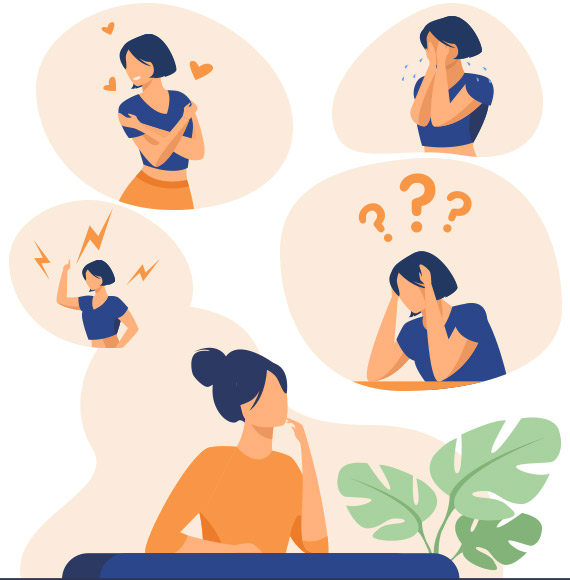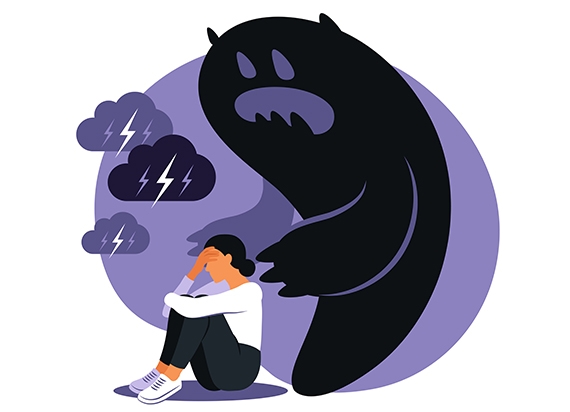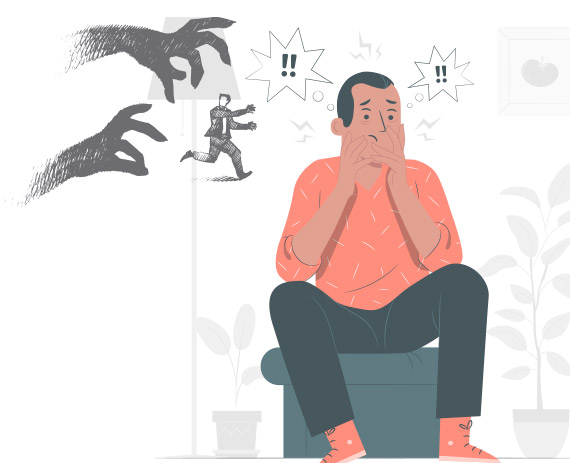Close

Anxiety
It is usually defined as a diffuse, vague, very unpleasant feeling of fear and apprehension. The anxious person worries a lot, particularly about unknown dangers. Anxiety is the commonest psychiatric symptom in clinical practice and anxiety disorders are one of the commonest psychiatric disorders in general population.
The ability to tolerate anxiety varies among people, and determining what constitutes abnormal anxiety can be difficult. However, when anxiety occurs at inappropriate times or is so intense and long-lasting that it interferes with a person’s normal activities, then it is properly considered a disorder. Anxiety disorders can be so distressing and interfere so much with a person’s life that they can lead to depression.
The disorders in this category include Generalized Anxiety Disorder, Panic Disorder, Phobic Disorder.

Generalized anxiety disorder
Generalized anxiety disorder is characterized by generalized and persistent anxiety not restricted to any particular situation (“free floating”). It consists of excessive, almost daily anxiety and worry lasting 6 months or longer about a variety of activities or events. Morbid apprehension of some dreadful happening is accompanied by various physical and psychological symptoms.
The anxiety and worry of generalized anxiety disorder are so extreme that they become difficult to control. The patient is unable to relax, sleep and eat properly. Worries are general in nature, common worries include work responsibilities, money, health, safety, car repairs, and chores. The severity, frequency, or duration of the worries is disproportionately greater than the situation calls for. The disorder substantially interferes with the patient’s life activities.
Anxiety Treatment
Drugs are the primary treatment for generalized anxiety disorder. Relaxation and biofeedback techniques may be of some help. Generalized anxiety disorder may be associated with underlying psychological conflicts. Such conflicts are frequently related to insecurities and self-critical attitudes that are self-defeating. For some people, psychotherapy may be effective in helping to understand and resolve internal psychological conflicts.
Panic Disorders
Panic is acute and extreme anxiety with accompanying physiological symptoms. Panic attacks may occur in any anxiety disorder, usually in response to a specific situation tied to the main characteristic of the disorder. For example, a person with a phobia of snakes may panic when encountering a snake. However, these situational panics differ from the spontaneous, unprovoked ones that define a person’s problem as panic disorder.
Panic Disorder Treatment
People respond better to treatment when they understand that panic disorder involves both biological and psychological processes. Drugs, behavioural therapy, psychotherapy, supportive psychotherapy can generally control the symptoms.


Phobic Disorders
Phobias involve persistent, unrealistic, intense anxiety in response to specific external situations, such as looking down from heights or coming near a small dog. People who have a phobia avoid situations that trigger their anxiety or they endure them with distress. However, they recognize that their anxiety is excessive and therefore are aware that they have a problem.
Agoraphobia means “fear of market place”, formerly the term was used to denote phobias of open places alone but it is now used in a wider sense. It refers to a trapped state and morbid fear of places and situations from where, the patient believes, he cannot escape easily to a “safer” place, usually home.
Typical situations that are difficult for people with agoraphobia include standing in line at a bank or supermarket, sitting in the middle of a long row in a theater or classroom, and riding on a bus, train or plane. In severe cases the patient becomes totally home bound or totally dependent on another person when he has to leave home.
In Social Phobia, morbid fear is experienced in situations where the patient is likely to be observed and criticized by others. Places like canteens or situations like meetings and parties are avoided by the patient.
Unlike in agoraphobia, social phobias occur in small, intimate groups. All symptoms of anxiety mounting up to panic may be present. Situations that commonly trigger anxiety among people with social phobia include public speaking; performing publicly, such as acting in a play or playing a musical instrument; eating in front of others; signing a document before witnesses; and using a public bathroom. People with social phobia are concerned that their performance or actions will seem inappropriate. Often, they worry that their anxiety will be obvious that they will sweat, blush, vomit, or tremble or that their voice will quiver; they will lose their train of thought; or they will not be able to find the words to express themselves.
Anxiety Therapy
The best treatment for is exposure therapy, a type of behaviour therapy. With the help of a therapist, the person seeks out, confronts, and remains in contact with what s/he fears until her/his anxiety is slowly relieved by familiarity with the situation (a process called habituation). Exposure therapy helps more than 90 percent of the people who practice it faithfully. Drugs aren’t very useful in helping people overcome specific phobias. However, anti-anxiety drugs may give a person short-term control over a phobia, such as the fear of flying.
Psychotherapy, with a view toward gaining insight and understanding of internal conflicts, may be helpful in identifying and treating the conflicts that may underlie a specific phobia. It involves talking with a therapist to better understand underlying conflicts, may be particularly helpful for people who are capable of examining their own behaviour and making changes in the way they think about and react to situations.
